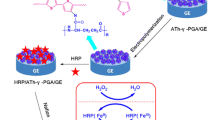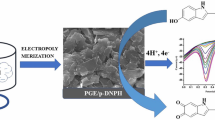Abstract
In this work, three polymeric films derived from hydroxyphenylacetic acid isomers were electropolymerized onto the surfaces of graphite electrodes through cyclic voltammetry. Analysis of electrochemical behaviors and electrical properties of the three polymeric films were investigated and their probably structures were explored by molecular modeling. The best functionalization strategy for the incorporation and retention of adenine and guanine nitrogenous bases was the poly(3-hydroxyphenylacetic acid). It was applied for the immobilization of a nucleotide probe specific to DNA of the bacteria Neisseria meningitidis operated in amperometric and impedimetric indirect modes. The simple protocol of electrochemical detection of DNA by the bioelectrode, developed in this work, could be further enhanced and applied in a low-cost and pain-less platform to diagnose human meningitis infection.









Similar content being viewed by others
References
Gade VK, Shirale DJ, Gaikwad PD et al (2006) Immobilization of GOD on electrochemically synthesized Ppy–PVS composite film by cross-linking via glutaraldehyde for determination of glucose. React Funct Polym 66:1420–1426. doi:10.1016/j.reactfunctpolym.2006.04.005
Zhou DM, Dai YQ, Shiu KK (2010) Poly(phenylenediamine) film for the construction of glucose biosensors based on platinized glassy carbon electrode. J Appl Electrochem 40:1997–2003. doi:10.1007/s10800-010-0179-6
D’Eramo F, Zón MA, Fernández H et al (2008) Studies of a novel conducting polymer by cyclic and square wave voltammetries: its synthesis and characterization. Electrochim Acta 53:7182–7190. doi:10.1016/j.electacta.2008.05.013
Eftekhari A, Jafarkhani P (2006) Polymerization of aniline through simultaneous chemical and electrochemical routes. Polym J 38:651–658. doi:10.1295/polymj.PJ2005181
Xue H, Shen Z, Zheng H (2002) In situ electropolymerized polyaniline-polyacrylonitrile composite film for the construction of a polyphenol oxidase-based biosensor. J Appl Electrochem 32:1265–1268. doi:10.1023/A:1021627007963
Ferreira DC, Rodrigues LP, Madurro JM, Graci A (2014) Graphite electrodes modified with poly (3-hydroxybenzoic acid) for oligonucleotides sensors. Int J Electrochem Sci 9:6246–6257
Ferreira LF, Souza LM, Franco DL et al (2011) Formation of novel polymeric films derived from 4-hydroxybenzoic acid. Mater Chem Phys 129:46–52. doi:10.1016/j.matchemphys.2011.03.053
Ferreira DC, Machado AEDH, Tiago FDS et al (2012) Molecular modeling study on the possible polymers formed during the electropolymerization of 3-hydroxyphenylacetic acid. J Mol Graph Model 34:18–27. doi:10.1016/j.jmgm.2012.01.001
Silva TAR, Ferreira LF, Boodts JFC et al (2008) Poly(4-hydroxyphenylacetic acid): a new material for immobilization of biomolecules. Polym Eng Sci 48:1963–1970. doi:10.1002/pen.21026
Ferreira LF, Santos CC, da Cruz FS et al (2014) Preparation, characterization, and application in biosensors of functionalized platforms with poly(4-aminobenzoic acid). J Mater Sci 50:1103–1116. doi:10.1007/s10853-014-8667-4
Ferreira LF, Boodts JFC, Brito-Madurro AG, Madurro JM (2008) Gold electrodes modified with poly(4-aminophenol): incorporation of nitrogenated bases and an oligonucleotide. Polym Int 57:644–650. doi:10.1002/pi.2392
Silva TAR, Ferreira LF, Souza LM et al (2009) New approach to immobilization and specific-sequence detection of nucleic acids based on poly(4-hydroxyphenylacetic acid). Mater Sci Eng C 29:539–545. doi:10.1016/j.msec.2008.09.048
Santos PS, Nascimento R, Rodrigues LP et al (2012) Functional epitope core motif of the Anaplasma marginale major surface protein 1a and its incorporation onto bioelectrodes for antibody detection. PLoS ONE 7:e33045. doi:10.1371/journal.pone.0033045
Da Silva Santos TV, Teixeira RR, Franco DL et al (2012) Bioelectrode for detection of human salivary amylase. Mater Sci Eng C 32:530–535. doi:10.1016/j.msec.2011.12.005
Travas-Sejdic J, Peng H, Yu H, Luo S-C (2011) DNA detection using functionalized conducting polymers. In: Mark SS (ed) Bioconjugation protocol, SE—27. Humana Press, Totowa, pp 437–452
Lien TTN, Lam TD, An VTH et al (2010) Multi-wall carbon nanotubes (MWCNTs)-doped polypyrrole DNA biosensor for label-free detection of genetically modified organisms by QCM and EIS. Talanta 80:1164–1169. doi:10.1016/j.talanta.2009.09.002
Patel MK, Solanki PR, Kumar A et al (2010) Electrochemical DNA sensor for Neisseria meningitidis detection. Biosens Bioelectron 25:2586–2591. doi:10.1016/j.bios.2010.04.025
Patel MK, Solanki PR, Seth S et al (2009) CtrA gene based electrochemical DNA sensor for detection of meningitis. Electrochem Commun 11:969–973. doi:10.1016/j.elecom.2009.02.037
Jorgensen WL, Maxwell DS, Tirado-rives J (1996) Development and testing of the OPLS all-atom force field on conformational energetics and properties of organic liquids. J Am Chem Soc 118:11225–11236
Tafi A, Agamennone M, Tortorella P et al (2005) AMBER force field implementation of the boronate function to simulate the inhibition of β-lactamases by alkyl and aryl boronic acids. Eur J Med Chem 40:1134–1142. doi:10.1016/j.ejmech.2005.06.011
Kohn W, Becke AD, Parr RG (1996) Density functional theory of electronic structure. J Phys Chem 100:12974–12980
Frisch MJ, Trucks GW, Schlegel HB et al (2010) Gaussian 09, Revision B.01. Gaussian Inc, Wallingford
Mohamadi F, Richards NGJ, Guida WC et al (1990) Macromodel—an integrated software system for modeling organic and bioorganic molecules using molecular mechanics. J Comput Chem 11:440–467
Li Z, Scheraga HA (1987) Monte Carlo-minimization approach to the multiple-minima problem in protein folding. Proc Natl Acad Sci USA 84:6611–6615
Radstrom P, Backman A, Qian N et al (1994) Detection of bacterial DNA in cerebrospinal fluid by an assay for simultaneous detection of Neisseria meningitidis, Haemophilus influenzae, and streptococci using a seminested PCR strategy. J Clin Microbiol 32:2738–2744
Tran LD, Piro B, Pham MC et al (2003) Electropolymerized polytyramine films: covalent binding of oligonucleotides and hybridization. Synth Metals 137:1439–1440. doi:10.1016/S0379-6779(02)01170-0
Oliveira RML, Vieira SN, Alves HC et al (2010) Electrochemical and morphological studies of an electroactive material derived from 3-hydroxyphenylacetic acid: a new matrix for oligonucleotide hybridization. J Mater Sci 45:475–482. doi:10.1007/s10853-009-3964-z
Rodrigues LP, Ferreira DC, Sonoda MT et al (2014) Electropolymerization mechanisms of hydroxyphenylacetic acid isomers. J Mol Struct 1072:298–306. doi:10.1016/j.molstruc.2014.05.031
Huang W, Humphrey BD, MacDiarmid AG (1986) Polyaniline, a novel conducting polymer. Morphology and chemistry of its oxidation and reduction in aqueous electrolytes. J Chem Soc Faraday Trans 1 Phys Chem Condens Phases 82:2385–2400. doi:10.1039/F19868202385
Benyoucef A, Huerta F, Ferrahi MI, Morallon E (2008) Voltammetric and in situ FT-IRS study of the electropolymerization of o-aminobenzoic acid at gold and graphite carbon electrodes: influence of pH on the electrochemical behaviour of polymer films. J Electroanal Chem 624:245–250. doi:10.1016/j.jelechem.2008.09.013
Fernandes P, Campinã J, Pereira N et al (2012) Biodegradable deep-eutectic mixtures as electrolytes for the electrochemical synthesis of conducting polymers. J Appl Electrochem 42:997–1003. doi:10.1007/s10800-012-0474-5
Watkins TI, Woolfe G (1952) Effect of changing the quaternizing group on the trypanocidal activity of dimidium bromide. Nature 169:506
Yang L, Li Y, Erf GF (2004) Interdigitated array microelectrode-based electrochemical impedance immunosensor for detection of Escherichia coli O157:h7. Anal Chem 76:1107–1113. doi:10.1021/ac0352575
Barsoukov E, MacDonald J (2005) Impedance spectroscopy: theory, experiment and application, 2nd edn. Wiley Interscience, New Jersey
Acknowledgments
The authors thank the Brazilian research agencies CNPq, FAPEMIG, and CAPES for their financial support and scholarships.
Author information
Authors and Affiliations
Corresponding author
Additional information
An erratum to this article is available at http://dx.doi.org/10.1007/s10800-017-1058-1.
Rights and permissions
About this article
Cite this article
Rodrigues, L.P., Ferreira, D.C., Ferreira, L.F. et al. Electropolymerization of hydroxyphenylacetic acid isomers and the development of a bioelectrode for the diagnosis of bacterial meningitis. J Appl Electrochem 45, 1277–1287 (2015). https://doi.org/10.1007/s10800-015-0892-2
Received:
Accepted:
Published:
Issue Date:
DOI: https://doi.org/10.1007/s10800-015-0892-2




